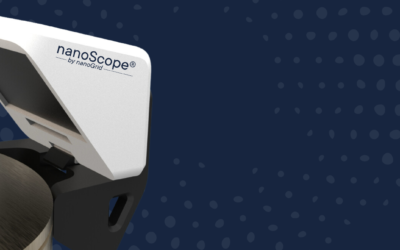IoT energy monitoring can cut your energy use by up to 30% (source: Moldstud). And in a world of rising costs, tighter ESG rules, and pressure to prove performance, that’s a number you just can’t ignore.
From logistics parks and retail stores to hospitals and manufacturing sites, IoT energy monitoring gives you live insights into how, where, and why energy is being used and wasted. Less guesswork. More control, sharper decisions, and measurable results.
Whether you’re chasing operational savings, ESG goals, or both. In this article, we’ll show you how it works, what benefits to expect, and why it’s quickly becoming a must-have for energy and sustainability teams across Europe.
Why energy monitoring is a strategic priority now
Energy costs are volatile, climate regulations are tightening, and operational systems are more complex and distributed than ever. From logistics parks and retail stores to healthcare campuses and manufacturing hubs. IoT energy monitoring systems can reduce energy consumption by 10-30% in commercial buildings (source: Moldstud). And with those numbers, one thing is clear: businesses can no longer afford to just guess how energy is being used.
That’s why IoT energy monitoring has moved from an innovation to a necessity. It gives companies real-time visibility into how energy is consumed across their operations. Down to the asset, system, or location. The result? Smarter energy usage, lower operational costs, and better decision-making.
But there’s more to it than just savings. With regulations and frameworks like ESG, CSRD, SFDR, and GRESB now demanding auditable energy efficiency metrics. Monitoring is also becoming a compliance essential. And with ESG goals and decarbonization pathways now part of mainstream business strategy, companies need accurate data to back up their sustainability claims. In short, IoT energy monitoring solutions deliver measurable value across both immediate and strategic timeframes:
- Short-term benefits: immediate energy savings (typically 10-30% reduction in consumption), proactive fault detection with up to 50% reduction in downtime, significant waste elimination, and intelligent resource optimization based on real-time data (sources: Moldstud and Business Norway).
- Long-term advantages: streamlined ESG reporting with automated, auditable data streams, extended asset lifespans through predictive maintenance, seamless regulatory compliance across evolving frameworks, and future-ready operations that adapt to emerging technologies and grid innovations.
The good news? IoT energy monitoring systems are more scalable, affordable, and accurate than ever before, giving enterprises full control over their energy footprint, no matter how large or complex the infrastructure.
Next up, let’s explain how these systems actually work, from sensor to dashboard, and how they unlock a new level of operational insight.
What is IoT Energy Monitoring?
In a nutshell, IoT energy monitoring is the process of using connected IoT devices to track how energy flows through a system, in real-time, and at any level of granularity.
It all starts with connected devices or sensors. These compact IoT devices are installed on key systems like HVAC units, lighting, machinery, refrigeration, and more. Each one tracks a specific metric: electricity use, temperature, voltage, pressure, or usage patterns.
The sensors collect data directly from the equipment, in real time. Updates happen every second or minute, depending on the setup. That data is sent via secure networks like Wi-Fi, LoRaWAN, NB-IoT, cellular, or Ethernet. Once transmitted, it’s safely stored and processed in the cloud. From there, everything can be visualised in any kind of dashboards. Users get real-time views of:
- Energy usage per site, system, or floor
- Cost estimates and performance benchmarks
- Unusual spikes or equipment inefficiencies
- Alerts for abnormal readings or potential system failures
- ….
With the right platform, teams can take immediate action: switch off unused loads, reschedule operations, launch predictive maintenance workflows, …
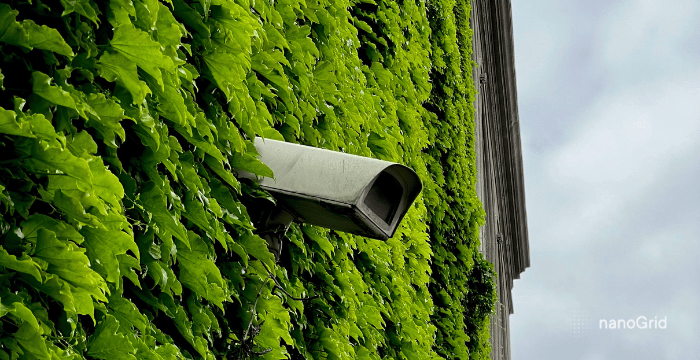
Real-time data beats guesswork
Unlike traditional energy audits that depend on monthly bills or one-off meter reads, IoT monitoring shows you what’s happening right now, giving you access to recent data for timely decision-making. Not weeks later.
That instant visibility is what makes the difference. You move from collecting data to using it. The data collection enables faster and more accurate responses. From reacting late to acting early. And most of all, you gain the tools to cut waste, lower costs, and improve sustainably. Across every building, device, and system you connect.
Now let’s take a closer look to the more strategic benefits and how it actually works.
How IoT energy monitoring works (behind the scenes)
To understand the full value of IoT energy monitoring, it helps to look beneath the dashboard. Here’s how it all works.
1. It starts with IoT sensors
At the heart of any IoT monitoring solution are the sensors: small, purpose-built IoT devices installed on key systems or infrastructure. Depending on the site and need, these may include:
- Smart meters: Track electricity usage per building, zone, or tenant.
- Energy meters: Monitor consumption and voltage in production lines or HVAC systems.
- Ambient sensors: Detect temperature, humidity, pressure, or occupancy to contextualize energy demand.
Each sensor continuously gathers real-time data about how much energy is being used, how efficiently it’s being used, and whether it matches expected performance.
2. Then comes communication
Once collected, IoT data has to move: fast and securely. That’s where communication protocols come in. Because efficient handling of incoming data streams is crucial. Depending on your site layout and infrastructure, data may be transmitted via:
- Wi-Fi: Ideal for office or retail environments with stable coverage
- LoRa / LPWAN: Perfect for long-distance, low-power transmission (e.g. across large campuses or industrial zones)
- NB-IoT (Narrowband Internet of Things): A cellular-based option for hard-to-reach areas
- 4G/5G: As a cellular backup when Wi-Fi isn’t reliable or unavailable
The right protocol ensures secured and uninterrupted IoT remote monitoring, even across remote or off-grid locations. The IoT network plays a key role in maintaining data integrity and security during transmission.
3. Live data processing and aggregation
Once transmitted, the real-time data processing part begins. The system aggregates incoming sensor data into centralized databases or cloud-based storage. From here, algorithms begin detecting patterns, comparing values to historical baselines, and identifying outliers, within a few seconds.
That’s how real time visibility is created: dashboards, reports, and alerts that reflect what’s happening now, not last week.
4. Automation, alerts, and smart actions
Here’s where value turns into action. Through automated processes, the technology or platform can:
- Trigger alerts when energy usage exceeds preset thresholds
- Detect anomalies that signal potential system faults or overconsumption
- Predictive maintenance using IoT data can prevent costly breakdowns in energy systems.
- Optimize operations by scheduling energy-heavy tasks during off-peak hours
IoT energy monitoring is a dynamic ecosystem where IoT devices, communication protocols, and real-time data intelligence work together to support energy savings, uptime, and long-term efficiency.
The role of real-time & historical data in energy optimization
In energy monitoring, data is the difference between reactive guessing and proactive control. But not just any data: you need real-time visibility and a solid foundation of historical data to truly optimize performance, as well as the ability to compare current data to past performance to uncover deeper insights. Each plays a distinct role.
Real-time data = fast insight, fast intervention
When a system starts over-consuming energy, real-time alerts let you act immediately. Whether it’s a faulty HVAC unit running overnight or a refrigeration system drifting outside optimal range, real-time tracking lets you:
- Detect anomalies before they cause downtime
- Trigger alerts and automated actions
- Maintain system health with minimal manual intervention
This level of visibility is essential for equipment performance and business continuity, especially in distributed or high-value sites.
Historical data = trend analysis and smarter planning
While real-time data tells you what’s happening now, historical data tells you why it keeps happening. By analyzing past patterns, you can:
- Benchmark sites or systems against each other
- Spot unusual patterns in consumption or efficiency
- Track the impact of upgrades, behavior changes, or new schedules
- Inform future resource utilization and energy budgeting
This kind of data infrastructure unlocks long-term savings. You no longer just respond to issues, you prevent them entirely.
The value of smart analytics and anomaly detection
When layered with data analytics, all your energy related data becomes even more powerful. Modern IoT monitoring solutions use AI and rule-based models to:
- Flag deviations from normal usage
- Predict potential system failures
- Highlight areas where you’re losing energy (and money)
Together, real-time monitoring and historical benchmarking create a closed-loop system for energy optimization. One that improves system health, supports ESG reporting, and empowers your teams to act, before costs spiral.
Why IoT energy monitoring is key to ESG, compliance & long-term ROI
Today, energy monitoring isn’t just about cutting utility bills. It’s about meeting investor expectations, proving regulatory alignment, and future-proofing real estate portfolios. IoT energy monitoring sits at the heart of this shift, linking daily energy use to long-term ESG and sustainability goals. It also supports supply chain optimization by providing improved energy visibility, which enhances logistics and operational efficiency.
With centralized monitoring, organizations gain comprehensive oversight and control of energy consumption across multiple sites, improving management and visibility.
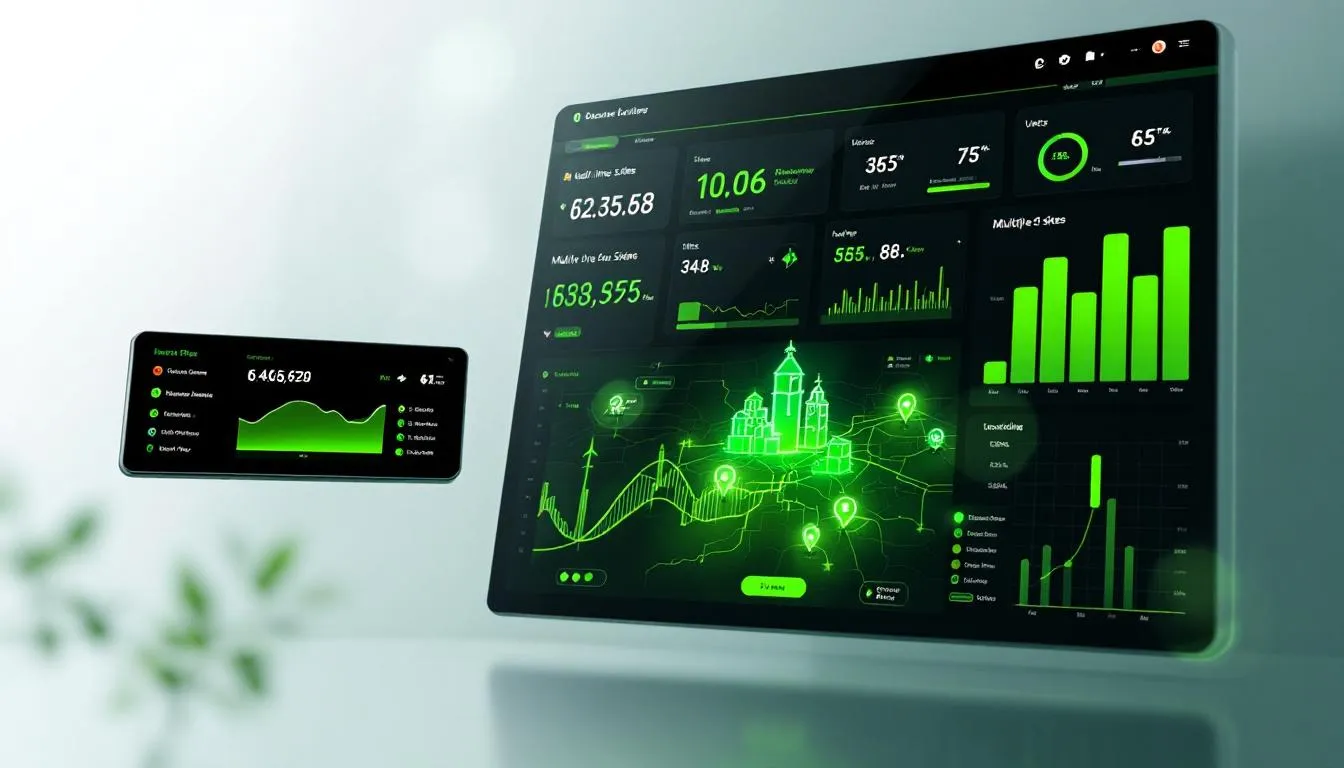
1. From energy usage to ESG strategy
Investors, regulators, and financial markets now demand real proof of environmental performance. Platforms like GRESB and CRREM are no longer optional, they’re the language of capital allocation. IoT energy monitoring delivers the data visualization and performance metrics that ESG frameworks require. Think:
- Verified Scope 1 & 2 emissions
- Real-time tracking of energy efficiency gains
- Auditable logs for disclosure and benchmarking
- Asset-level insights aligned with net-zero pathways
Whether you’re preparing for CRREM risk assessments or meeting CSRD energy intensity requirements, having traceable, granular energy data from connected IoT sensors makes reporting fast, reliable, and defensible.
2. Predictive planning and regulatory readiness
By tracking real-time energy consumption and storing historical data, IoT monitoring solutions enable early warning systems and predictive maintenance. This supports:
- Efficient energy audits
- Proactive retrofit planning
- Smarter allocation of ESG-related capital expenditure
Rather than reacting to poor performance during an audit, your teams can stay ahead of compliance with hard evidence, and clear visibility on where improvements will generate the best ROI.
3. Boosting long-term asset value
ESG and energy performance now factor into net present value (NPV) calculations and market appraisals. With rising scrutiny from banks, insurers, and institutional investors, IoT monitoring helps you:
- Protect assets from stranding risk
- Prove operational resilience and operational efficiency
- Build stakeholder confidence in sustainability reporting
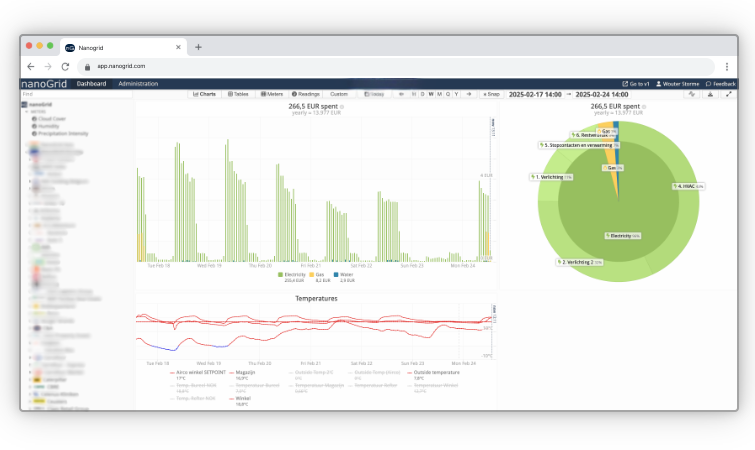
NanoGrid utility data SaaS dashboard interface
How nanoGrid Supports enterprise-wide energy monitoring
Most energy IoT monitoring platforms stop at the dashboard. At nanoGrid, we go much deeper: offering a centralized IoT platform that works across building types, meters, and utility systems. Our solution was built for real-world complexity, not lab conditions.
We ensure data security and quality through built-in data protection, hardware redundancy, and failover capabilities, so your IoT data remains secure and accessible even during outages.
Full control, from meter to platform
We provide a full-stack solution. From plug-and-play sensors to cloud-based reporting. That means:
- Minute-level real time visibility into energy use, water, gas, and district heating
- Submetering-ready hardware, even for sealed or legacy meters
- On-site IoT devices that function regardless of manufacturer, age, or location
- Data encrypted and stored for long-term audits, ESG disclosures, or internal benchmarks
No manual readings. No untraceable data. Just one centralized view. 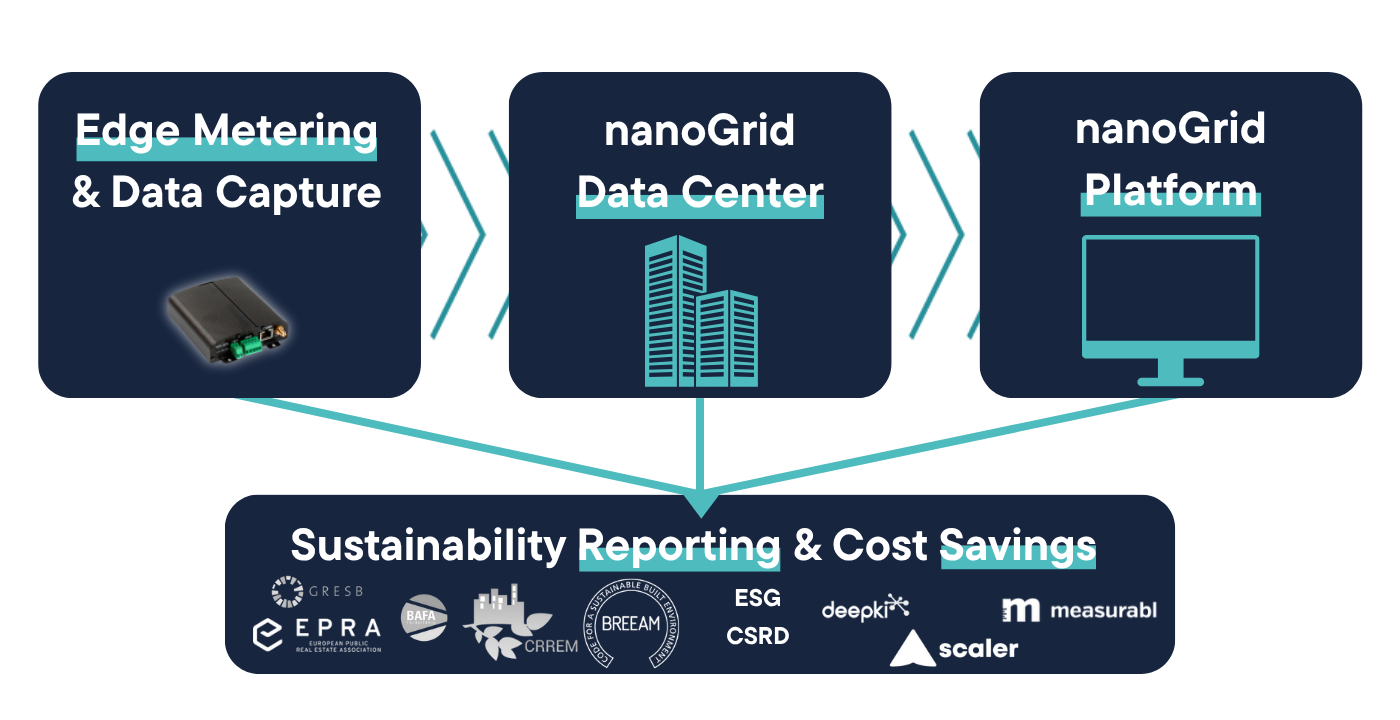
Integration-ready, compliance-aligned
nanoGrid seamlessly connects to ESG-platforms like Measurabl, Deepki, Scaler, and many more. We help big commercial real estate companies to:
- Cut consumption at the source: minute-level metering spotlights hidden waste across every building, so you can drive continuous efficiency gains and decarbonisation.
- Automate ESG data collection and reporting, eliminating manual spreadsheets and late-night reconciliations.
- Keep an eye on every energy source: real-time anomaly detection flags leaks, faults and consumption spikes the instant they occur, with root-cause insights for rapid fix-times.
- Have less admin, more action: end-to-end automation (sensors → cloud → dashboards → APIs) slashes operational workload, letting your team focus on strategic sustainability wins.
Whether you’re monitoring a retail chain, logistics hubs, or critical manufacturing sites, nanoGrid brings data clarity to every square meter.
Conclusion: See deeper, waste less – energy visibility starts here
Energy efficiency is no longer just a line item. It’s a strategic asset. With energy prices, ESG regulations, and operational risk on the rise, having full control over your energy consumption data has never been more valuable. IoT energy monitoring unlocks that control: turning your buildings, meters, and systems into intelligent sources of insight.
You can cut waste, plan better, stay compliant, and boost long-term performance metrics. Our intuitive dashboards turn fully traceable, minute-level data into live, actionable insight. Empowering multi-site enterprises to cut costs, curb waste, and automate every ESG target with confidence.
Interested in learning more? Book a personal demo and discover our approach in action.




